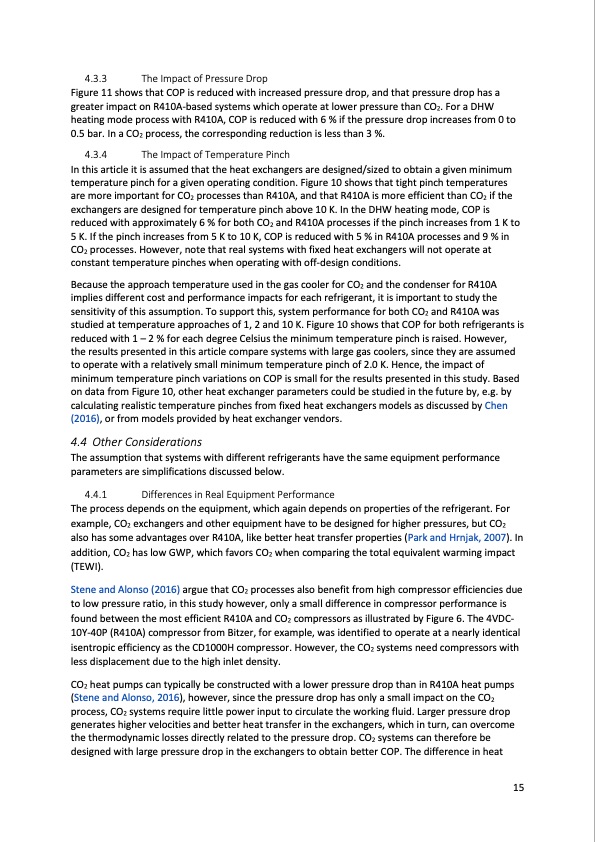
PDF Publication Title:
Text from PDF Page: 015
4.3.3 The Impact of Pressure Drop Figure 11 shows that COP is reduced with increased pressure drop, and that pressure drop has a greater impact on R410A-based systems which operate at lower pressure than CO2. For a DHW heating mode process with R410A, COP is reduced with 6 % if the pressure drop increases from 0 to 0.5 bar. In a CO2 process, the corresponding reduction is less than 3 %. 4.3.4 The Impact of Temperature Pinch In this article it is assumed that the heat exchangers are designed/sized to obtain a given minimum temperature pinch for a given operating condition. Figure 10 shows that tight pinch temperatures are more important for CO2 processes than R410A, and that R410A is more efficient than CO2 if the exchangers are designed for temperature pinch above 10 K. In the DHW heating mode, COP is reduced with approximately 6 % for both CO2 and R410A processes if the pinch increases from 1 K to 5 K. If the pinch increases from 5 K to 10 K, COP is reduced with 5 % in R410A processes and 9 % in CO2 processes. However, note that real systems with fixed heat exchangers will not operate at constant temperature pinches when operating with off-design conditions. Because the approach temperature used in the gas cooler for CO2 and the condenser for R410A implies different cost and performance impacts for each refrigerant, it is important to study the sensitivity of this assumption. To support this, system performance for both CO2 and R410A was studied at temperature approaches of 1, 2 and 10 K. Figure 10 shows that COP for both refrigerants is reduced with 1 – 2 % for each degree Celsius the minimum temperature pinch is raised. However, the results presented in this article compare systems with large gas coolers, since they are assumed to operate with a relatively small minimum temperature pinch of 2.0 K. Hence, the impact of minimum temperature pinch variations on COP is small for the results presented in this study. Based on data from Figure 10, other heat exchanger parameters could be studied in the future by, e.g. by calculating realistic temperature pinches from fixed heat exchangers models as discussed by Chen (2016), or from models provided by heat exchanger vendors. 4.4 Other Considerations The assumption that systems with different refrigerants have the same equipment performance parameters are simplifications discussed below. 4.4.1 Differences in Real Equipment Performance The process depends on the equipment, which again depends on properties of the refrigerant. For example, CO2 exchangers and other equipment have to be designed for higher pressures, but CO2 also has some advantages over R410A, like better heat transfer properties (Park and Hrnjak, 2007). In addition, CO2 has low GWP, which favors CO2 when comparing the total equivalent warming impact (TEWI). Stene and Alonso (2016) argue that CO2 processes also benefit from high compressor efficiencies due to low pressure ratio, in this study however, only a small difference in compressor performance is found between the most efficient R410A and CO2 compressors as illustrated by Figure 6. The 4VDC- 10Y-40P (R410A) compressor from Bitzer, for example, was identified to operate at a nearly identical isentropic efficiency as the CD1000H compressor. However, the CO2 systems need compressors with less displacement due to the high inlet density. CO2 heat pumps can typically be constructed with a lower pressure drop than in R410A heat pumps (Stene and Alonso, 2016), however, since the pressure drop has only a small impact on the CO2 process, CO2 systems require little power input to circulate the working fluid. Larger pressure drop generates higher velocities and better heat transfer in the exchangers, which in turn, can overcome the thermodynamic losses directly related to the pressure drop. CO2 systems can therefore be designed with large pressure drop in the exchangers to obtain better COP. The difference in heat 15PDF Image | CO2 Heat Pump Performance

PDF Search Title:
CO2 Heat Pump PerformanceOriginal File Name Searched:
co2-heat-pump-comparative-study.pdfDIY PDF Search: Google It | Yahoo | Bing
CO2 Organic Rankine Cycle Experimenter Platform The supercritical CO2 phase change system is both a heat pump and organic rankine cycle which can be used for those purposes and as a supercritical extractor for advanced subcritical and supercritical extraction technology. Uses include producing nanoparticles, precious metal CO2 extraction, lithium battery recycling, and other applications... More Info
Heat Pumps CO2 ORC Heat Pump System Platform More Info
| CONTACT TEL: 608-238-6001 Email: greg@infinityturbine.com | RSS | AMP |